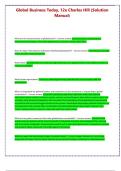Global Business Today, 12e Charles Hill (Solution
Manual)
What are the characteristics of globalization? - Correct answer-Communication, transportation,
transnational businesses, free trade agreements, consumer culture, labor force.
How do major international institutions facilitate globalization? - Correct answer-International monetary
funds: provides financial stability.
World bank: reconstruction and restructuring economies as an opportunity to reach global solutions to
national challenges.
World trade organization: focuses on lowering/removing trade barriers to encourage trade and
globalization.
Why is it important for political leaders and institutions to be transparent in responding to global
competition? - Correct answer-Successful institutions play three important roles: they channel
information about market conditions, goods, services, and participants; they define property rights and
contracts; they promote competition and innovation the foundations of the globalized business world
are political and so are the biggest threats to the system. World bank encourages political institutions to
be transparent and convince their constituents that while globalization does create "winners" and
"losers" policies will be in place to retain and uplift the downtrodden.
What are key policy measures that make globalization sustainable? - Correct answer-Countries with
sound economic policies will be more successful in the global economy, encouraging further opening
and cross border integration. Governments need to put in place good governance, competitive markets,
and property rights, and assist in the fight against corruption.
What are ways that technology bridges the global divide? - Correct answer-Advances in technology
along with the lower costs to obtain internet access and technology is allowing for underdeveloped
, Global Business Today, 12e Charles Hill (Solution
Manual)
countries to now utilize it and the advantages of technology lessening the digital divide and closing the
gap between developed and developing countries and markets.
What is the rationale of specific anti-globalization arguments? - Correct answer-Arguments against
globalization highlight problems such as the cost of disruptive economic change including job losses and
stagnant wages, the loss of local control over economic policies and developments, the disappearance
of old industries, and related erosion of communities
What are the benefits of trade? - Correct answer-trade benefits consumers in three major ways:
A greater amount of choice in the availability of goods and services;
Lower prices for goods and services consumed; and
Higher living standards.
Trade has influenced culture, shaped history, raised living standards, and expanded knowledge to
include new ways of thinking.
What are the benefits of foreign investment? - Correct answer-Foreign direct investment (FDI) in a
country brings funds and business culture from abroad, creates new well-paying jobs, introduces
innovative technologies, and enhances the skills of domestic workers. Because of the largely positive
impact that FDI has on countries, governments all over the world try to create a business-friendly
environment to attract such investments.
What are the major international trade theories and what are key features of each one? - Correct
answer-mercantilism
absolute advantage
comparative advantage
Heckscher-Ohlin theory
, Global Business Today, 12e Charles Hill (Solution
Manual)
factor-price equalization theory
Porter's Diamond Model
What is the impact of trade policy on various stakeholders such as businesses, consumers, and
governments? - Correct answer-limiting imports from those firms trade barriers help domestic
companies.
Consumers may suffer, though, as import restrictions result in higher prices.
What is the rationale for managing trade? - Correct answer-Managed trade refers to agreements,
sometimes temporary, between countries (or a group of countries) that aim to achieve certain trade
outcomes for the countries involved. Managed trade aims to replace global market or economic forces
with government actions to determine trade outcomes. Under a managed trade regime, policymakers
may use various socio-economic or geo-political rationales to protect specific companies or industries
and achieve particular strategic objectives.
What are the costs of regional economic integration? - Correct answer-undermining the most-favored-
nation status rule (the lowest tariff applicable to one member must be extended to all members), an
essential principle of the WTO.
Imposing laws and regulations that are uniform, and that at times do not take into account national
economic, cultural, and social differences.
Eliminating jobs and increasing unemployment in protected industries.
Losing sovereignty, national independence, and identity.
Reducing the powers of the national government.
Increasing the probability of rising crime associated with illegal drugs and terrorism because of ease of
cross-border labor movement.
, Global Business Today, 12e Charles Hill (Solution
Manual)
What are key aspects of economic geography? - Correct answer-market size, location, and openness to
trade
What are the reasons why countries pursue regional integration? - Correct answer-Regional integration
helps countries—especially small and medium-sized countries—scale up their supply capacity through
regional production networks and become more globally competitive.
What are the characteristics of each regional integration bloc? - Correct answer-Two or more countries
could join together to form a regional integration bloc. The main objectives for integration could be:
economic; geo-political; social; and/or regional security
What is meant by the "balance of payments" for a country? - Correct answer-refers to a statement of
account that summarizes all transactions between the residents of one country and the rest of the world
for a given period of time, usually one year.
What are the components of the foreign exchange market? - Correct answer-spot, forward, and futures
markets.
What are the critical components of culture? - Correct answer-learned behavior; a way of life for one
group of people living in a single, related, and independent community
What are the primary and secondary sources that can be used to learn about foreign countries'
cultures? - Correct answer-primary sources are talking to employees who have lived or worked abroad,
executives who have traveled to other countries, training programs, and consulting firms.
Secondary source examples include the U.S. Department of Commerce Country Commercial Guide,
Country Reports from The Economist's Intelligence Unit, and Price Waterhouse Coopers' Doing Business
in 118 Countries.
What are facets of culture that are significant for doing business in various countries, including East
Asian, Arabian, and Latin American countries? - Correct answer-




